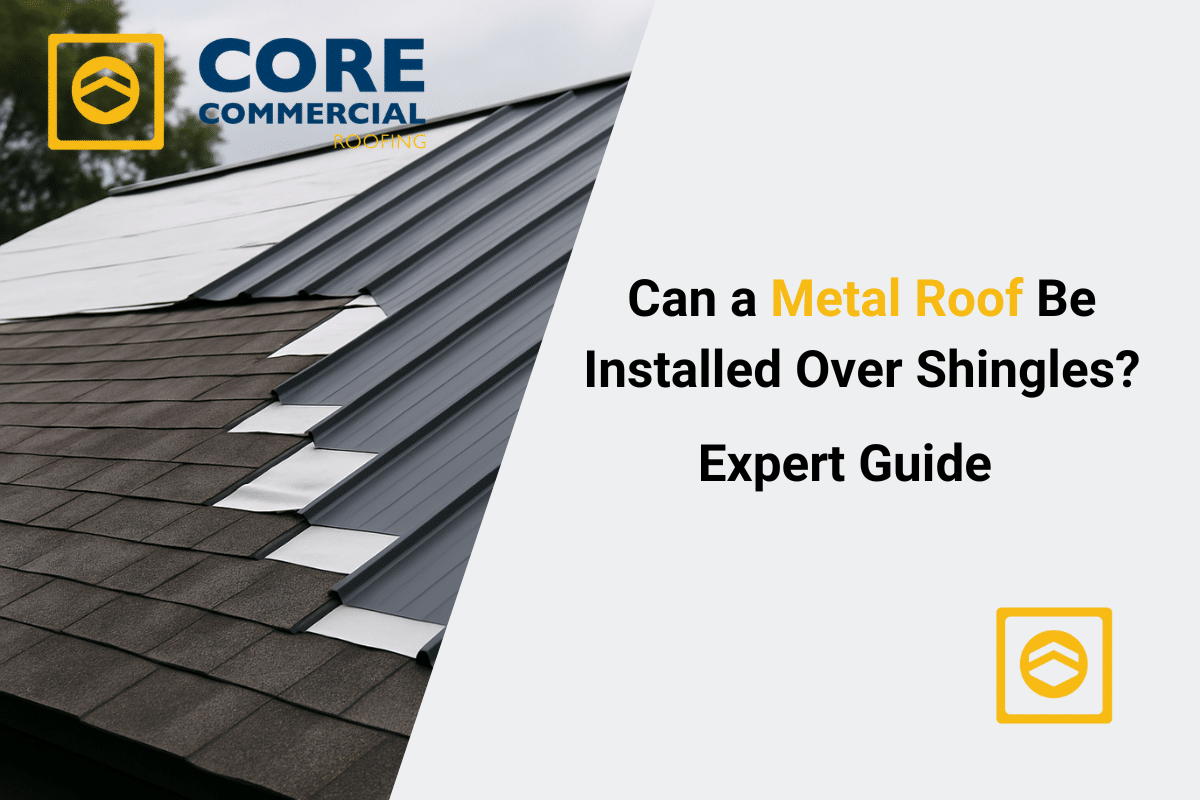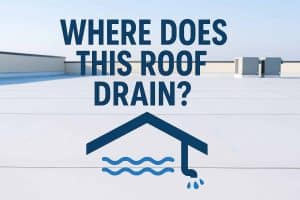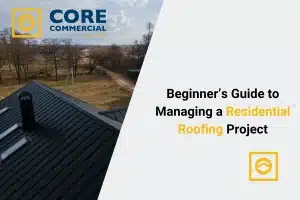Thinking about upgrading to a metal roof but unsure if you need to rip off your old shingles first? You’re not alone. Many homeowners ask, “Can a metal roof be installed over shingles?”—and the answer may surprise you. Yes, in many cases, you can install a metal roof over existing shingles. But it’s not always that simple. This guide will walk you through everything you need to know—from the pros and cons to building codes, insulation concerns, and long-term durability. Whether you’re looking to save money, reduce mess, or boost your home’s energy efficiency, this article will give you the expert knowledge you need to make an informed decision.

Table of Contents
Why Homeowners Consider Metal Roofs Over Shingles
Many homeowners start exploring metal roofs because their current asphalt shingles are aging, curling, or leaking. But tearing off the old roof can be time-consuming, messy, and expensive. So the big question becomes: “Can we just cover it up instead?”
Installing a metal roof over shingles is often considered for:
- Saving Money: Removing shingles can cost hundreds to thousands in labor and dumpster rental.
- Saving Time: Overlaying a new metal roof can speed up the installation process.
- Reducing Landfill Waste: Shingles aren’t exactly eco-friendly. Leaving them in place keeps them out of landfills.
- Better Energy Efficiency: Metal roofs reflect sunlight, lowering cooling costs.
- Longevity: Metal roofs often last 40–70 years, compared to shingles that last 15–25 years.
Is It Legal to Install Metal Roofing Over Shingles?
Yes, but it depends on local building codes, roof condition, and manufacturer guidelines. Most areas in the United States allow up to two layers of roofing material. So if you only have one layer of shingles, a metal roof can usually be installed over it.
Pro Tip: Always check with your local building department or city code enforcement office before starting.
Key considerations include:
- How many layers are currently on the roof?
- What’s the condition of the underlying structure?
- Do local codes allow overlays?
- Does your HOA have roofing material restrictions?
Pros of Installing a Metal Roof Over Shingles
1. Cost Savings
Not having to tear off your old shingles can save $1,000–$3,000 or more in labor and disposal fees.
2. Quicker Installation
Without the need for removal, crews can install metal roofing faster, often in a matter of days.
3. Less Mess
No dumpster in your driveway, no debris in your yard, and no leftover nails to step on.
4. Insulation Bonus
Your existing shingles provide an extra layer of insulation and soundproofing, which can be helpful during storms.
5. Environmental Impact
Fewer shingles going to the landfill = better for the environment. Metal is also recyclable at the end of its life.
Cons and Risks You Shouldn’t Ignore
While the overlay method offers several advantages, there are important downsides:
1. Trapped Moisture
If the shingles underneath are holding moisture, you risk rot, mold, or mildew.
2. Uneven Surface
Wavy or curled shingles can lead to bumps and reduce the aesthetic of your new metal roof.
3. Extra Weight
Most metal roofs are lightweight, but adding any material increases the overall load. If your decking or rafters are weak, this could be a problem.
4. Hidden Structural Damage
If you don’t remove the shingles, you might miss spotting a rotten section of roof decking or water damage.
5. Voided Warranty
Some metal roof manufacturers void warranties if installed over old shingles without following specific underlayment requirements.
You may read: commercial roofing systems
How to Know if Your Existing Roof Is a Good Candidate
Before jumping into installation, evaluate the condition of your existing shingles and roof deck. Ask yourself or your contractor:
- Are the shingles flat and secure, or curling and loose?
- Is the roof decking underneath still solid and dry?
- Have there been any leaks or water damage inside your attic?
- Are you within the legal limit of roofing layers?
Pro Tip: Walk your attic and check for dark stains, wood rot, or musty smells. These are signs you shouldn’t skip the tear-off.
Types of Metal Roofs Suitable for Over-Shingle Installation
Not all metal roofing systems are ideal for installation over shingles. The most suitable types include:
1. Standing Seam Metal Roofs
These have hidden fasteners and raised seams. They offer durability, weather resistance, and a sleek, modern look.
2. Metal Shingles
These mimic the look of asphalt, slate, or wood shakes. Lightweight and interlocking, they can often be applied directly over shingles.
3. R-Panel Metal Roofs
Popular in rural areas, they’re cost-effective but may require furring strips or underlayment for smoother installation.
How Installation Works: Step-by-Step Guide
Here’s a simplified walkthrough of how a professional might install a metal roof over your shingles:
Step 1: Inspection
The contractor checks roof structure, shingle condition, and ensures it’s legal and safe to overlay.
Step 2: Install Underlayment
This layer protects against moisture and helps prevent condensation issues. Common types include synthetic felt or foam insulation.
Step 3: Add Furring Strips (Optional)
Also called purlins, these create a flat surface for metal panels and improve ventilation.
Step 4: Install Metal Panels or Shingles
Using fasteners, interlocking panels are installed across the roof, following the manufacturer’s specs.
Step 5: Add Flashing and Trim
Edges, valleys, and roof penetrations (chimneys, vents) get sealed with flashing to prevent water intrusion.
Step 6: Final Inspection
Contractor checks fasteners, overlaps, seams, and edges to ensure everything is watertight and meets code.
Common Mistakes to Avoid
Even a great roofing system can fail if installed poorly. Watch out for:
- Skipping underlayment: Moisture buildup can ruin your roof from the inside out.
- Installing over damaged shingles: Always fix sagging or rotting areas first.
- Improper ventilation: A metal roof without airflow can trap heat and moisture.
- Not following local codes: Violating building codes could lead to fines or forced tear-offs.
Cost Comparison: Tear-Off vs. Overlay
| Item | Full Tear-Off | Metal Over Shingles |
|---|---|---|
| Labor Costs | High ($1,000–$3,000+) | Lower ($500–$1,000) |
| Dumpster/Rental Fees | $300–$600 | None or minimal |
| Time to Install | 5–7 Days | 2–4 Days |
| Structural Inspection | Easier | Harder (roof is hidden) |
| Long-Term Maintenance | Potentially lower | May require more attention |
Final Tip: A tear-off may be the smarter investment if your shingles or deck are already compromised.
Final Thoughts: Should You Do It?
Installing a metal roof over shingles can be a great way to extend the life of your roof, save money, and upgrade your home’s look and efficiency. But it’s not always the best route. You need to weigh structural integrity, code compliance, and long-term performance.
Bottom line: If your existing roof is in good condition, your local code allows it, and you hire a reputable contractor, installing metal over shingles can be a smart and efficient roofing solution.
FAQs
Can you put a metal roof over shingles without removing them?
Yes, you can install a metal roof over existing shingles if your roof structure is in good shape and local building codes allow it. This method saves time and money by avoiding the need to tear off the old shingles. However, it’s essential to ensure there’s no underlying damage or moisture issues before proceeding.
Is it cheaper to install metal roofing over shingles?
Installing metal roofing over shingles can be more cost-effective because it eliminates the labor and disposal costs associated with removing the old roof. However, the overall savings depend on the condition of your existing roof and local labor rates.
Do I need underlayment when installing a metal roof over shingles?
Yes, adding an underlayment between the metal roof and existing shingles is crucial. It acts as a moisture barrier, prevents potential leaks, and provides additional insulation, enhancing the roof’s performance and longevity.
Will a metal roof over shingles be noisy during rain?
A properly installed metal roof with adequate insulation and underlayment shouldn’t be noisier than other roofing types. These layers help dampen the sound of rain, ensuring a comfortable indoor environment.
Does installing a metal roof over shingles affect home value?
Yes, a metal roof can increase your home’s value. Metal roofs are durable, energy-efficient, and low-maintenance, which are attractive features for potential buyers. They also offer a modern aesthetic that can enhance curb appeal.
How long does a metal roof over shingles last?
A metal roof installed over shingles can last between 40 to 70 years, depending on the materials used and the quality of installation. Regular maintenance and inspections can help maximize its lifespan.
Can I install a metal roof over two layers of shingles?
Most building codes allow only one layer of roofing over existing shingles. Installing over two layers can add excessive weight and may not comply with local regulations. It’s best to consult with a professional roofer to assess your specific situation.
Is a metal roof over shingles energy efficient?
Yes, metal roofs reflect solar heat, reducing cooling costs in warmer months. When installed over shingles with proper insulation, they can enhance your home’s energy efficiency by maintaining more stable indoor temperatures.
What are the risks of putting a metal roof over shingles?
Potential risks include trapping moisture between layers, which can lead to mold or rot, and hiding existing structural issues. Ensuring proper ventilation and a thorough inspection before installation can mitigate these risks.
Do I need a permit to install a metal roof over shingles?
Yes, most localities require a permit for roofing projects, including installing a metal roof over shingles. It’s important to check with your local building department to ensure compliance with all regulations and codes.






